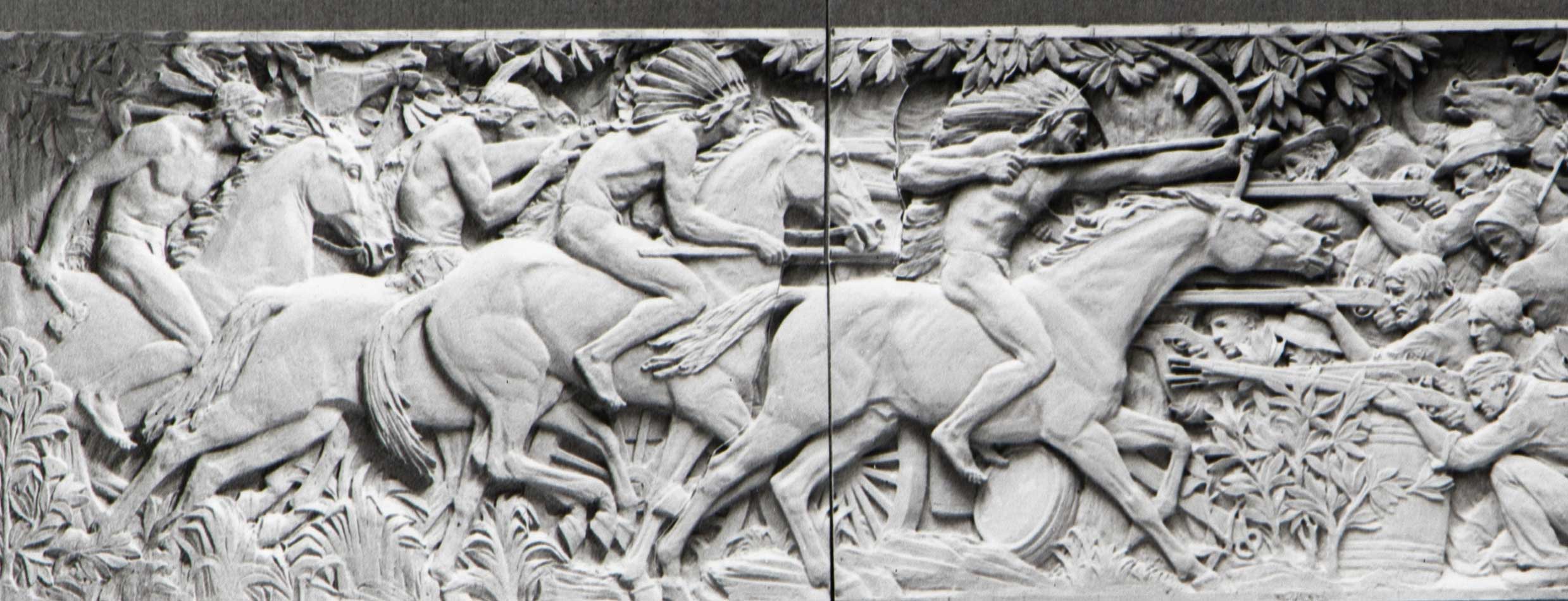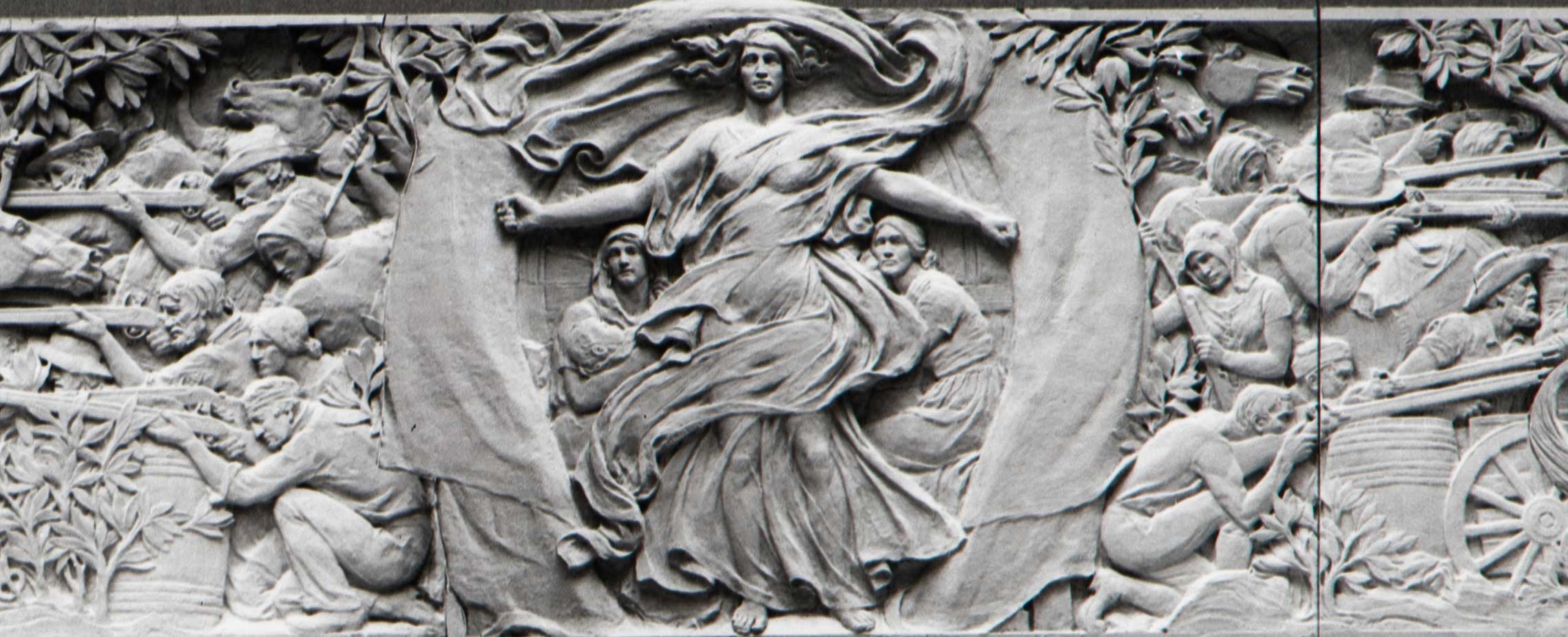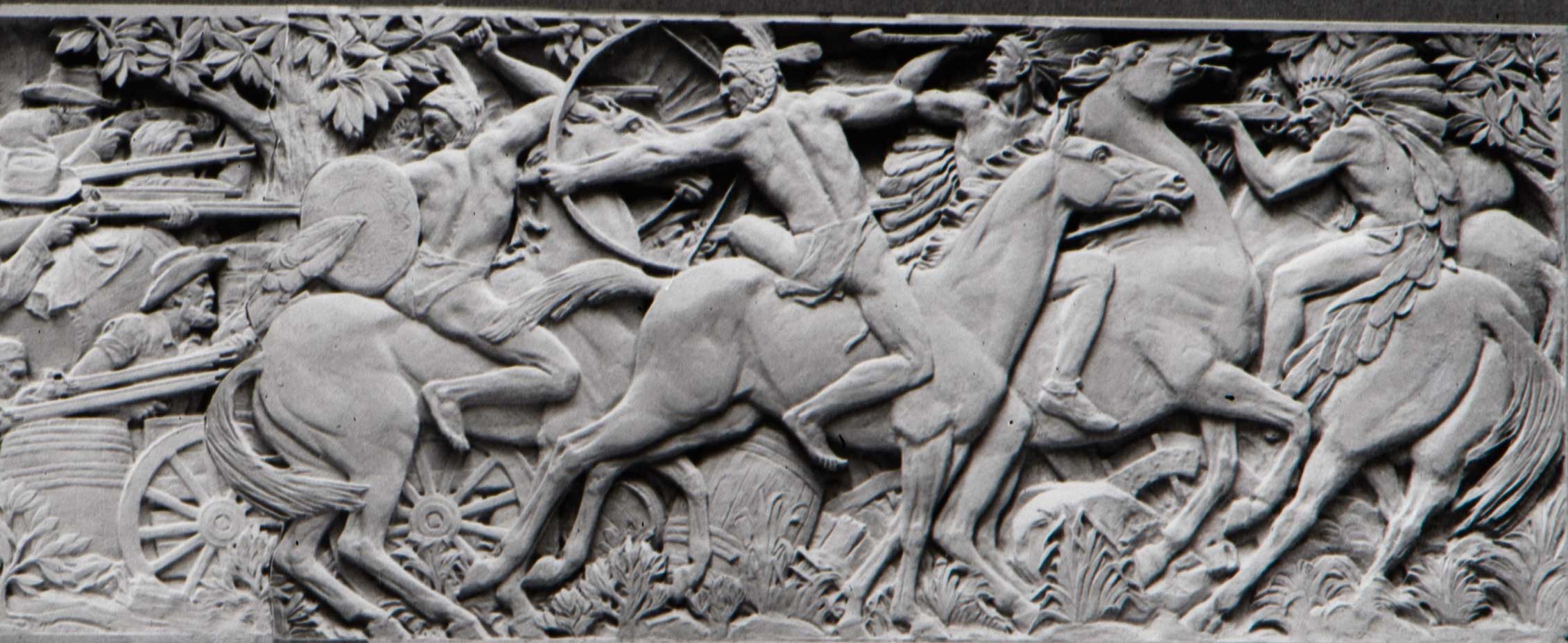One of the Nelson-Atkins buildings has 23 panels carved on the outside, high up and kind of hard to see–really see. They tell a story of the colonial settlement of the Midwest, filled with harmful stereotypes of Native Americans. The story is biased fiction, but it’s told like monumental history. In this episode, we look closer at these monuments in public space with Native artists Mona Cliff, Alex Ponca Stock, Lucky Garcia, and Alex Kimball Williams.
About the Guests
Mona Cliff, Ha-nuk-gah-Nay (Spottedcloud) is a multidisciplinary visual artist. She explores contemporary Native American identity and culture, generational knowledge, and Native futurism through traditional Native crafting methods such as seed bead embroidery and fabric applique. Mona also works as a Diversity, Equity, and Inclusion field representative for Indigenous communities for the Kansas Creative Arts Industry Commision. She recently completed a commissioned installation for the Kansas City Museum and is embarking on a commissioned beaded piece for the Kansas City International Airport Terminal 1% for the Arts program. Mona lives in Lawrence, KS, with her husband and three children. She is enrolled A’aninin (Frozen Clan) of the Ft. Belknap Indian community, Ft Belknap, MT.
Alex Ponca Stock has the great privilege of being a painter from the Gray Horse District of the Osage Nation. Her clan is the Ponca Washtage or Gentle Leaders. Stock is the third generation in her family to graduate from the Kansas City Art Institute and pursue the life of an artist. Stock’s work is an investigation of community, culture, experience, and perception. For the past decade, she has dedicated her practice to elevating her Osage community and other Indigenous groups in partnerships with the Osage Nation Foundation, the Osage Museum, Illuminative, Pipestem Law Firm, International Sites of Conscience and the National Endowment for the Arts.
Lucky Garcia (she/her/hers) is an Indigenous/Chicana writer, performing artist, community organizer, race equity educator, and software engineer in Kansas City, MO. An Iraq War Veteran turned political leftist, she has dedicated her life and work to social justice. Lucky speaks publicly and teaches on women’s, veteran’s, and prisoner rights, as well as LGBTQ, political, and racial justice issues. She is a Co-Director with Anytown KC Youth Leadership Institute, an organizing member of One Struggle KC in the Movement for Black Lives, founding member of Brown Voices/Brown Pulse which centers LGBTQ people of color, organizer with Showing Up for Racial Justice – Kansas City, co-founder of the Sex In the Middle Conference, and a founding member of the La Resistencia poetry collective.
Alex Kimball Williams, a Lawrence Native, is the artivist (artist+activist) behind the Bad Alaskan project. Bad Alaskan is composed of synth-based electronic music with dance and meditative vibes. Their music combines different influences to model and examine multiracial identities. Alex writes scores for films and themes for podcasts, conducts music workshops centered on improvisation and storytelling, performs during protests & community events, and more. You may recognize them from The Lawrence Songbook, Field Day Fest, the Festival of Cultures, Girls Rock Lawrence, or other events.
Additional Voices:
Jake Wagner, Associate Professor of Urban Planning & Design, University of Missouri–Kansas City
Tara Laver, Senior Archivist, the Nelson-Atkins
Rachel Nicholson, Director, Interpretation, Evaluation & Visitor Research, the Nelson-Atkins
About the Host
Glenn A. North is an award-winning poet, activist, educator, and arts executive based in Kansas City. He is currently the Director of Inclusive Learning & Creative Impact at the Kansas City Museum. He has previously served at the Bruce R. Watkins Cultural Center, American Jazz Museum, and The Black Archives of Mid-America. Having earned an M.F.A. in Poetry from the University of Missouri-Kansas City, Glenn also conducts Ekphrastic poetry workshops, as well as using poetry to address issues of social justice, diversity, equity, and inclusion, and self-empowerment.
The Art in the Episode
Relief carved on the south façade of the Nelson-Atkins building, designed by Charles Keck (American, 1875–1951). Completed 1933, limestone. Detail left; detail center; detail right.
This is one of 23 panels designed by Charles Keck that wrap around the outside of the original Nelson-Atkins building. Together, they tell a story about the Midwest that today we might call a celebration of settler colonialism, or land occupation that results in the genocide and repression of Indigenous peoples and cultures. Keck himself described this image as, “A struggle between the Indians and white men for the right of possession. The central figure represents Fortitude protecting the pioneers.” He designed it 40 years after the U.S. Army massacred at least 150 Lakota people at the Battle of Wounded Knee and the myth of the total extinction of Native American peoples took root. Deeper interpretation of this and the other panels, guided by contemporary Native knowledge and experience, is part of the work ahead for the Nelson-Atkins.
Resources
Native American Art Collection: The Nelson-Atkins’ collection of Native American art includes almost 2,000 objects, 200 of which are on view. They include pottery, basketry, quill and beadwork, textiles, painting, and sculpture.
Osage Nation Museum: The oldest tribal museum in the United States, founded in 1938, fostering the education of the public about the history, culture, and artistic expressions of the Osage people. Alex Ponca Stock’s grandfather Carl Ponca was the museum’s director for many years.
Nelson-Atkins Land Acknowledgment: Read our current land acknowledgement and more about our process to revise it in partnership with a multitribal Native American advisory group.
A guide to Land Acknowledgments: From the Native Governance Center, tips for creating a land acknowledgment, including self-reflection, research, and language.
Library Guide, The Plains Indians: Some starting points for further learning on the art and cultures of Native people with homelands in the Great Plains.
Credits
A Frame of Mind is the podcast of the Nelson-Atkins Museum of Art. This episode was produced and co-written by Glenn North and Christine Murray. Editing and sound design by Brandi Howell. Interview recording by Tim Harte. Studio engineering by Simpson Sound Lab. Fact checking by Kate Carpenter. Theme music by The Black Creatures. Additional music by Eclipse. Cover art by Two Tone Press.
Thanks to advisory group members Jimmy Beason II, José Faus, Allan Gray, Ron Jones, and Nia Richardson.
Produced in partnership with Jocelyn Edens and Kim Masteller, and with support from Anne Manning, Rachel Nicholson, Brent Bellew and the Nelson-Atkins Teen Council.
Produced with generous support from Bank of America, N.A., Trustee of the John W. and Effie E. Speas Memorial Trust.



